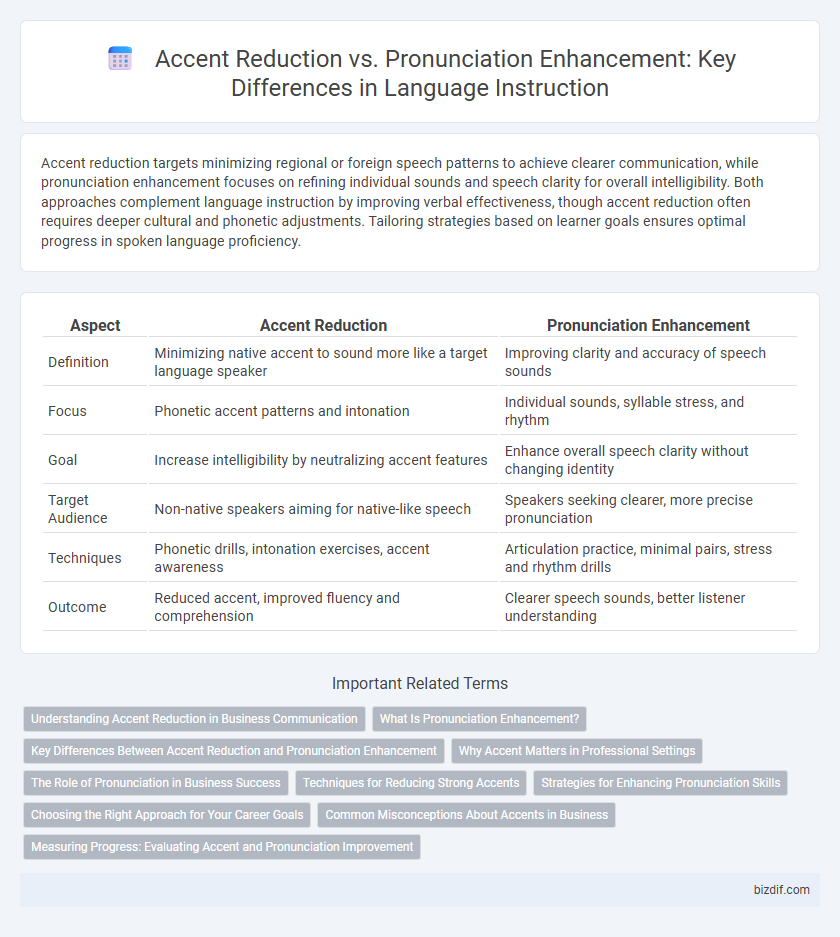Accent reduction targets minimizing regional or foreign speech patterns to achieve clearer communication, while pronunciation enhancement focuses on refining individual sounds and speech clarity for overall intelligibility. Both approaches complement language instruction by improving verbal effectiveness, though accent reduction often requires deeper cultural and phonetic adjustments. Tailoring strategies based on learner goals ensures optimal progress in spoken language proficiency.
Table of Comparison
| Aspect | Accent Reduction | Pronunciation Enhancement |
|---|---|---|
| Definition | Minimizing native accent to sound more like a target language speaker | Improving clarity and accuracy of speech sounds |
| Focus | Phonetic accent patterns and intonation | Individual sounds, syllable stress, and rhythm |
| Goal | Increase intelligibility by neutralizing accent features | Enhance overall speech clarity without changing identity |
| Target Audience | Non-native speakers aiming for native-like speech | Speakers seeking clearer, more precise pronunciation |
| Techniques | Phonetic drills, intonation exercises, accent awareness | Articulation practice, minimal pairs, stress and rhythm drills |
| Outcome | Reduced accent, improved fluency and comprehension | Clearer speech sounds, better listener understanding |
Understanding Accent Reduction in Business Communication
Accent reduction in business communication emphasizes modifying speech patterns to improve clarity and reduce misunderstandings, fostering effective interactions across diverse professional environments. This process involves targeted exercises to adjust intonation, rhythm, and vowel sounds, minimizing regional or foreign accents that may hinder comprehension. Pronunciation enhancement, while related, focuses more broadly on articulating individual sounds correctly, supporting clearer speech but not necessarily addressing accent-related challenges in global business settings.
What Is Pronunciation Enhancement?
Pronunciation enhancement involves refining individual speech sounds to improve clarity and intelligibility, enabling effective communication across diverse English dialects. It targets specific phonetic elements such as vowel and consonant articulation, stress patterns, and syllable emphasis to reduce misunderstandings. Unlike accent reduction, which aims to neutralize regional speech traits, pronunciation enhancement focuses on optimizing sound production while preserving unique vocal identity.
Key Differences Between Accent Reduction and Pronunciation Enhancement
Accent reduction targets minimizing regional or cultural speech patterns to foster clearer communication, while pronunciation enhancement focuses on refining the articulation and clarity of individual sounds. Accent reduction involves altering intonation, rhythm, and stress patterns to sound more native-like, whereas pronunciation enhancement emphasizes correct vowel and consonant production. Both approaches improve verbal intelligibility but address different aspects of speech modification in language instruction.
Why Accent Matters in Professional Settings
Accent reduction and pronunciation enhancement improve clarity and ensure effective communication in professional settings. Clear speech minimizes misunderstandings and fosters stronger interpersonal connections, boosting confidence during presentations and meetings. Employers value precise language skills as they contribute to a polished and professional image.
The Role of Pronunciation in Business Success
Mastering clear pronunciation enhances effective communication, which directly influences negotiations, presentations, and client relationships in business environments. Accent reduction minimizes misunderstandings and fosters trust, creating smoother interactions among diverse colleagues and international partners. Pronunciation enhancement drives professional credibility, enabling professionals to convey competence and build confidence in competitive markets.
Techniques for Reducing Strong Accents
Techniques for reducing strong accents primarily involve targeted phonetic training, intonation practice, and muscle memory development to adjust speech patterns. Utilizing audio feedback tools and immersive language environments helps learners internalize correct pronunciation and rhythm. Consistent practice with minimal pairs and stress-timed exercises accelerates accent modification and promotes clearer communication.
Strategies for Enhancing Pronunciation Skills
Effective strategies for enhancing pronunciation skills include targeted phonetic exercises, auditory discrimination training, and consistent practice with native speaker models. Utilizing technology such as speech recognition software provides real-time feedback, accelerating accuracy in vowel and consonant articulation. Incorporating prosody training improves intonation, rhythm, and stress patterns, essential for natural and clear speech.
Choosing the Right Approach for Your Career Goals
Selecting between accent reduction and pronunciation enhancement depends on your career goals and communication needs. Accent reduction focuses on minimizing regional or foreign accents to improve clarity and professional perception, while pronunciation enhancement emphasizes articulating sounds correctly to boost overall intelligibility. Evaluating job-specific language requirements and desired speech outcomes ensures the best approach for effective communication in your industry.
Common Misconceptions About Accents in Business
Many professionals mistakenly believe that accent reduction means eliminating their natural accent entirely to succeed in business communication. Pronunciation enhancement focuses on improving clarity and intelligibility without erasing cultural identity, making it a more effective approach. Understanding that accents add value rather than barriers promotes better cross-cultural collaboration and workplace inclusion.
Measuring Progress: Evaluating Accent and Pronunciation Improvement
Measuring progress in accent reduction involves assessing the clarity and comprehensibility of speech through standardized accent rating scales and listener evaluations. Pronunciation enhancement progress can be tracked by analyzing specific phoneme accuracy and intonation patterns using acoustic analysis software and phonetic transcription. Combining quantitative metrics and qualitative feedback ensures a comprehensive evaluation of speaking skills improvement.
Accent reduction vs Pronunciation enhancement Infographic

 bizdif.com
bizdif.com